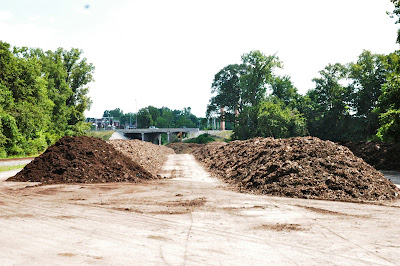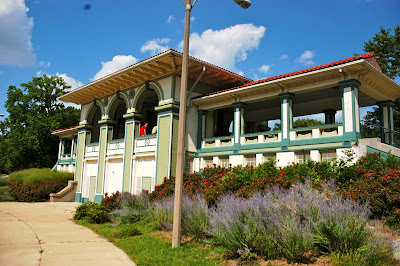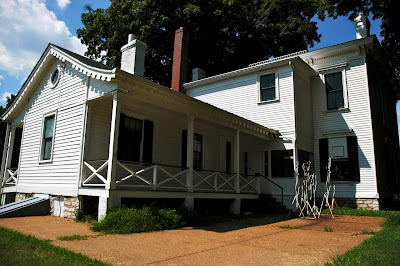This area came to be a target for redevelopment when the Laclede Gas "gasometer", a long time visible sight from I-64 just south of Barnes Jewish Hospital, was torn down in 2007:
Photo by: Built St. Louis
There was also a sister tank to the west at one time, dismantled in the 1960s. An excellent write up on the gasometers was done by Built St. Louis (one of the best STL blogs out there).
This is also the site of the much debated Aventura housing development which many city lovers have accused as looking "straight outta Ballwin" or a suburban vinyl black eye on an otherwise urban, classy brick neighborhood. I will be doing a story on the Aventura and Cortona housing developments upon completion, so I'll keep my opinions hushed for now.
Photo Source: Aventura
The future Chouteau Park space can be seen just to the east.
Photo Source: Aventura
Chouteau Park is just largely a graded empty lot right now, awaiting funds to become a fully realized park space. The design was done by H3 studios in 2009 who seem to be the firm that does all the park designs/master plans (Fox Park, Carondelet, etc).
The full plan can be found here. An update was provided by Washington University Medical Center Redevelopment Corp. back in November, 2011:
For the past few weeks, it may look like tractors have just been moving dirt around on a previous vacant lot, but they are actually creating the hills and play areas that will go with the future Chouteau park. The park plan calls for a multipurpose field, playground, and outdoor amphitheater. The park will also feature a rain garden to reduce water run-off into the sewer system. (source)The following revised renderings from the H3 2009 design include a shaded promenade, adventure playground, spray fountain and park cafe:
I look forward to this park becoming reality...although I'd rather see more housing that brings residents who in turn bring $, density, vibrancy, larger potential electorate, etc. The park master plan looks interesting and should be a nice addition to the neighborhood.
Update January 1, 2014: the classic St. Louis park sign has been added and trees are being planted.



































































































































